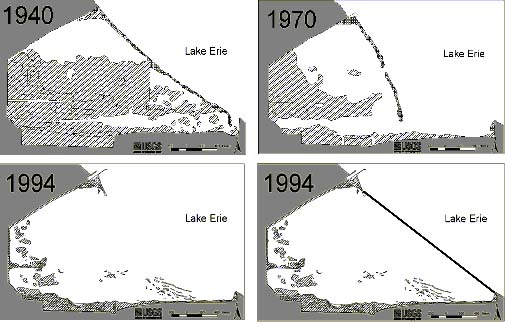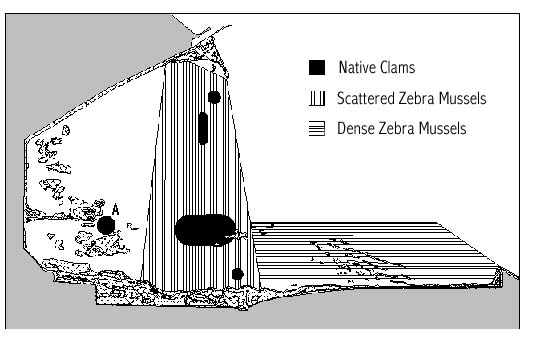 |
 |
Reestablishing the Freshwater Unionid Population of Metzger Marsh,
Lake Erie
One of the most devastating ecological problems resulting from
the recent invasion of North America by zebra mussels (Dreissena
polymorpha) has been the virtual elimination of native clams or
unionids from infested waters. Zebra mussels readily colonize clam
shells, disrupting feeding, movement, and reproduction. Clams
generally die within 1-2 years after infestation. This die-off has
been well-documented in the Great Lakes (Schloesser and Nalepa,
1994; Schloesser et al. 1996), with near total mortality
reported throughout most of western Lake Erie. However, in 1996, we
discovered a large population of native clams in a western Lake Erie
wetland, Metzger Marsh, that showed little sign of infestation
despite zebra mussel colonization of the site since about 1990.
Metzger Marsh is a lake-connected wetland located 32 km east of
Toledo, Ohio. Prior to 1940, portions of this 367-ha site were diked,
actively farmed, and then abandoned and allowed to revert back to
wetlands (Figure 1). The wetland embayment was protected from storm
activity by a barrier beach, which gradually eroded as sediment
supply decreased due to progressive armoring of the shoreline of the
lake. By 1990, much of the original wetland had also eroded. In
1994, a consortium of federal, state, and private organizations
joined forces to restore the wetland and provide improved habitat
for fish and wildlife. A dike was constructed across the opening of
the embayment to mimic the protective function of the lost barrier
beach, with plans to dewater the wetland to promote seed germination
and growth of emergent plants. Following two years of drawdown, a
water-control structure was placed in the dike to mimic the natural
barrier opening and was opened to restore hydrologic connection with
the lake.
|

Figure 1.
Schematic of aerial photographs of Metzger Marsh, western Lake
Erie, showing the destruction of the barrier beach and
subsequent erosion of wetland vegetation between 1940 and
1994. Hatched areas represent patches of wetland
vegetation. The bottom drawing shows the location of the
artificial barrier beach built at the site. |
Surveys of the biota before construction of the dike identified a
large population of zebra mussels in the lakeward half of the site
(Figure 2). Two types of zebra mussel colonization occurred: 1)
extensive layers, several centimeters thick, totally covering the
substrate and 2) individual clusters of mussels limited to hard
structures such as logs, rocks, or vegetation. The area totally
covered by zebra mussels extended about 150 m by 300 m. Five live
unionids, representing two species, Quadrula quadrula and
Leptodea fragilis, were also found in the surveys. Since so few
live unionids were collected and the entire area was colonized by
zebra mussels, scientists involved in the project hypothesized,
based on best available information (Schloesser & Nalepa 1994) that
only a small remnant clam population was present. However, the
dewatering process later exposed a clam population far more
extensive than expected.
|
Figure 2.
Distribution of zebra mussels and thick-shelled unionids
collected from Metzger Marsh, western Lake Erie, 1996. "Dense
zebra mussels" refers to areas where extensive colony mats
covered the substrates and "scattered zebra mussels" to areas
where minimal substrate colonization occurred by all other
objects (vegetation, rocks, logs, etc.) were colonized with
the exception of the unionids. "A" marks the site where the
oldest and largest individuals of all species were collected.
 |
About 7000 live unionids representing 20 species, including three
State of Ohio threatened species, and multiple year classes were
found during the dewatering (Table 1). Once this population was
discovered, a conglomerate of state and federal officials met to
decide what to do with these animals. To become a functioning
wetland, Metzger Marsh had to be dewatered first, a process which
would likely result in the destruction of the entire population. On
the other hand, the invasion of zebra mussels meant that release of
the unionids into Lake Erie proper would also result in their
destruction. This population was considered critical to the future
restoration of unionids in the western basin of Lake Erie, since it
is one of the few Lake Erie genetic stocks to have survived the
negative effects of zebra mussels. The Great Lakes Science Center
was charged with removing, boarding, and "doing something
appropriate" with these animals until they could be returned to
Metzger Marsh sometime in the future. In partnership with the EPA,
our primary goal was to salvage as much of the unionid fauna as
possible, and to use this fauna to ultimately rebuild the population
in Metzger Marsh.
|

